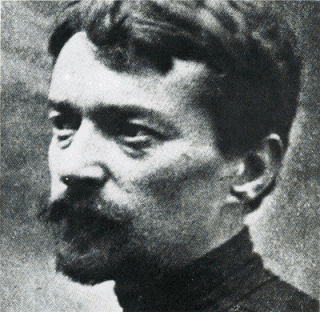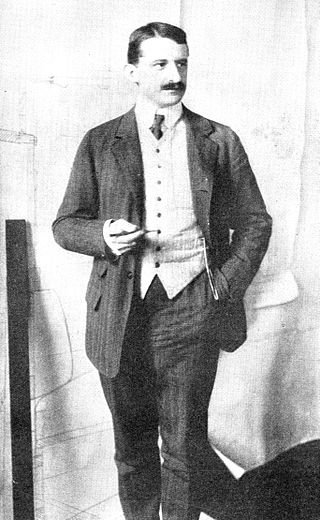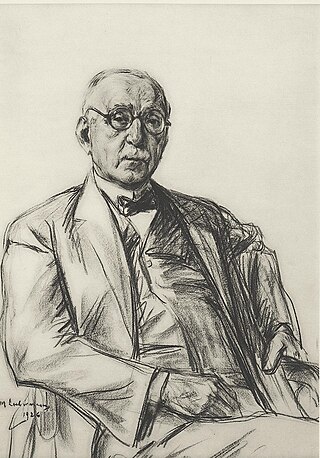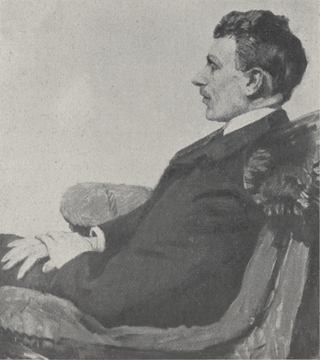Biography
From 1876, he studied archaeology and classical philology at Humboldt University of Berlin, then at the University of Bonn. In 1881, he returned to Berlin to study with Ernst Curtius and presented his thesis on the theme of Theoxenia (offering hospitality to a God in disguise), which earned him his PhD. After that, he turned to art history and worked at the Museum für Kunst und Gewerbe Hamburg. From 1897 to 1922, he served as the first Director of the Kaiser-Wilhelm-Museums [ de ] in Krefeld.
There, he built up a collection of contemporary art; primarily Impressionism and Art Nouveau. He was also involved in an effort to establish a collaboration between local industries and artists or craftsmen ; such as Peter Behrens, Henry van de Velde, Otto Eckmann and Joseph Maria Olbrich. Later, he became one of the founders of the Deutscher Werkbund and campaigned for the establishment of a Kunstgewerbeschule in Krefeld. In 1904, Johan Thorn Prikker was appointed as one of the first teachers there.
He served as a delegate to numerous major art exhibitions. Notable works include Linie und Form (1904), Die Sammlung niederrheinischer Tonarbeiten (1914) and Die Sammlung japanischer Farbenholzschnitte (1922)
Aktien-Gesellschaft Vulcan Stettin was a German shipbuilding and locomotive building company. Founded in 1851, it was located near the former eastern German city of Stettin, today Polish Szczecin. Because of the limited facilities in Stettin, in 1907 an additional yard was built in Hamburg. The now named Vulcan-Werke Hamburg und Stettin Actiengesellschaft constructed some of the most famous civilian German ships and it played a significant role in both World Wars, building warships for the Kaiserliche Marine and the Kriegsmarine later.

Johan Thorn Prikker was a Dutch artist who worked in Germany after 1904. His activities were very eclectic, including architecture, lithography, furniture, stained-glass windows, mosaics, tapestries and book covers as well as painting. He also worked in a variety of styles; such as Symbolism, Impressionism and Art Nouveau.

Bruno Paul was a German architect, illustrator, interior designer, and furniture designer.

Wilhelm von Bode was a German art historian and museum curator. Born Arnold Wilhelm Bode in Calvörde, and known as Wilhelm Bode for most of his career, he was ennobled in 1913, and thereafter adopted the aristocratic "von". He was the creator and first curator of the Kaiser Friedrich Museum, now called the Bode Museum in his honor, in 1904.
Bethan Huws is a Welsh multi-media artist whose work explores place, identity, and translation, often using architecture and text. Her work has been described as "delicate, unobtrusive interventions into architectural spaces".

Abraham David Christian is a German sculptor.

Cuno von Uechtritz-Steinkirch was a German sculptor.
Norbert Prangenberg was an abstract painter, sculptor, and engraver who was born in Nettseheim, just outside of Cologne, Germany. Though he had no formal training and did not fully engage with art until his 30s, Prangenberg did finally come up with a style that was uniquely his own, not fitting comfortably into the neo-expressionist or neo-geo movements of his time, in the 1970s and 1980s. At this time, he was considered a major figure in contemporary German art. Though he got his start with abstract paintings, he also became known for making sculptures of all sizes; and while his work initially appears abstract, the titles given sometimes allude to the human body or a landscape. As a trained gold- and silversmith, as well as a glassblower, he always showed an attention to materials and how they could be physically engaged with. He was interested in how his own two hands could affect the painting or sculpture's surface. Traces of the artist's hand appear literally throughout his entire oeuvre, before he lost the battle with liver cancer in 2012.

Wilhelm Waetzoldt was a German art historian, professor of art history in Halle, Geheimer Oberregierungsrat in the Prussian Ministry of Culture and from 1927 to 1933 general director of the Berlin State Museums.

Oscar Huldschinsky was a German coal and steel entrepreneur, art collector and philanthropist.

Karl Gustav Rutz was a German sculptor.

Helmut Hentrich was a German architect who became particularly known for his striking high-rise buildings in the 1960s and 1970s. The architectural firm he founded, Hentrich, Petschnigg und Partner (HPP), still exists under the name HPP Architekten.
Elfriede Klara Emma Reichelt was a German fine-art photographer.
Hermann Stiller was a German architect and director of the Kunstgewerbeschule Düsseldorf.
Felix Gottfried Wehling was a German architect.

The Kunstmuseen Krefeld is collection of three art museums in Krefeld, Germany. and particularly dedicated to modern and contemporary art. Comprising the Kaiser Wilhelm Museum, the Haus Lange and Haus Esters, the museums since the late 1950s have risen to international prominence. Katia Baudin, former deputy director of the Museum Ludwig in Cologne, has headed the institution since September 2016.
Max Creutz was a German art historian and curator of the Museum für Angewandte Kunst Köln and the Kaiser-Wilhelm-Museum in Krefeld where he worked from 1922 until his death. In Cologne, in 1914 he was instrumental in the first exhibition of the Deutscher Werkbund, Deutsche Werkbundausstellung. In Krefeld, he succeeded in acquiring modern art exhibits, including works by Max Ernst, Wassily Kandinsky, and Alexej von Jawlensky. He included a substantial collection of art, crafts and design from the Bauhaus.

Alfred Gold was an Austrian writer, theatre critic, journalist, art collector, and dealer.

Margarete Oppenheim was a German art collector and patron. She was among the first personalities to collect works of modern art in Germany and owned one of the largest collection in Germany. She is also known as Margarete Oppenheim-Reichenheim.
Julius Bernhard Stern was a German Jewish banker, art collector and philanthropist.












